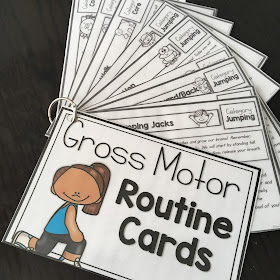
Gross Motor and Speech Therapy
I have learned a lot this past year working with an OT and attending OT workshops. I am turning over a new leaf this coming school year. Instead of just targeting speech, I am going to incorporate some OT activities, to help my students. Using OT activities is especially great for students struggling
in their classroom settings.
"Occupational therapy is the treatment, which focuses on helping people
to achieve independence. This independence is to be achieved throughout
their lives and not solely in one area. Through fun activities students
are taught many important techniques by their therapists. Teachers are not
equipped in most instances to deal with emotional and developmental needs,
unless they've received special training."
What I've learned:
1. First a lot of kids (some have not been identified) need help with their gross and fine motor skills.
Some of the kids we work with in speech may have special needs or have been diagnosed with a disability.These kids, in particular, need extra practice working on pencil grasp, cutting, pincer grasp, and other OT related areas.
2. We can target both in Speech, easily. I have recently learned that adding a few, easy and fun activities we can turn an ordinary therapy session into a multidisciplinary approach to speech therapy. It is easy for you, and beneficial for students! You can do this with play-doh, crayons, bean bags, scissors, and blocks!
Recently, I purchased KinderGrossMotor cards to help get my speech therapy students moving, but I realized it can help with so many other things.
The cards target five main areas: strength, core, stretching, balance
and jumping.
Not only does it get the kids up and moving, but it helps them concentrate and use some muscles in speech.
This is what Tara says:
"Research shows us that core strengthening for young students is the building block for not only gross motor but several developing skills. The students’ core muscles are those in their abdomen, back and pelvis. Those core muscles are the ‘control center’ for everything the body does. These core muscles give the students the ability to balance and ability to perform coordinated movements on both sides, and they will effect several tasks the child is required to make throughout the school day. The students lacking in any of those areas might struggle with: sitting in their chair, holding a pencil, controlling their scissors and jumping. These lacking skills stem from a majority of outside factors but the leading cause is the decline in physical activity for young students. More and more students are living a sedentary lifestyle through the use of technology devices. By performing gross motor activities in the classrooms, teachers are able to provide a type of engagement that the students might not have experienced at all or little exposure to..."
If you've ever been on TPT you've definitely heard of Tara West or her Little Minds at Work blog. She is awesome and her products are amazing. If you want to check out her blog click here!
The Kinder Gross Motor pack is so easy to make.
You can make it into full sheets or half, and it's really that easy: just print, laminate and cut. This all sounds good to me and I can't wait to implement it this fall!
I also have some free OT fine motor bins in my store that help with pincer grasp, and letter recognition.
**
I am not trying to take the place of any OT therapy, just trying to
give the kids who need extra help a boost, plus any extra help will
benefit everybody :)
Information obtained from: https://www.uvm.edu/~cdci/iteam/documents/IntegratingTherapyIntoClassrooms1.pdf
http://healthcareathome.ca/southeast/en/care/Documents/Tips%20to%20help%20teachers.pdf




No comments:
Post a Comment